Learning Experience 9: Hypertension Management with Exercise Analysis
VerifiedAdded on 2022/10/11
|11
|1990
|13
Report
AI Summary
This paper provides an analysis of hypertension and the effects of mild to moderate exercise on blood pressure. It includes measurements taken after various exercises such as arm curls, bench presses, leg extensions, and leg presses, explaining the rationale behind the observed differences in blood pressure. The report highlights how different muscle groups and breathing techniques influence blood pressure during exercise, also addressing the influence of supine position. Furthermore, it designs a tailored exercise program for a 50-year-old man with hypertension, outlining specific exercises, intensity levels, and rationales for each component, emphasizing the importance of stretching, slow jogging, resistance training, and deep breathing. The conclusion emphasizes the significance of deep breathing during exercise to manage blood pressure effectively. Desklib offers a wealth of study resources, including past papers and solved assignments, to support students in their academic pursuits.
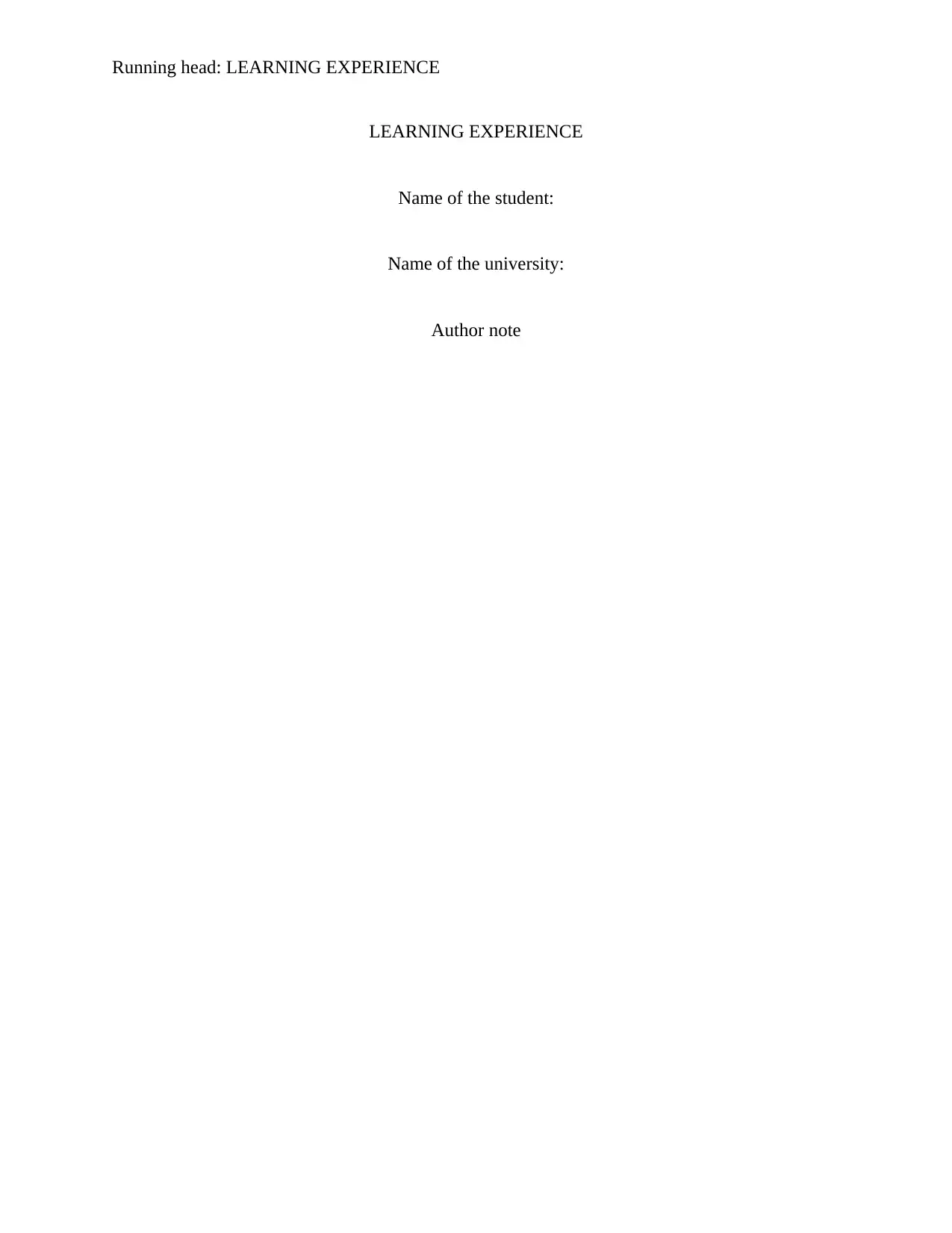
Running head: LEARNING EXPERIENCE
LEARNING EXPERIENCE
Name of the student:
Name of the university:
Author note
LEARNING EXPERIENCE
Name of the student:
Name of the university:
Author note
Paraphrase This Document
Need a fresh take? Get an instant paraphrase of this document with our AI Paraphraser
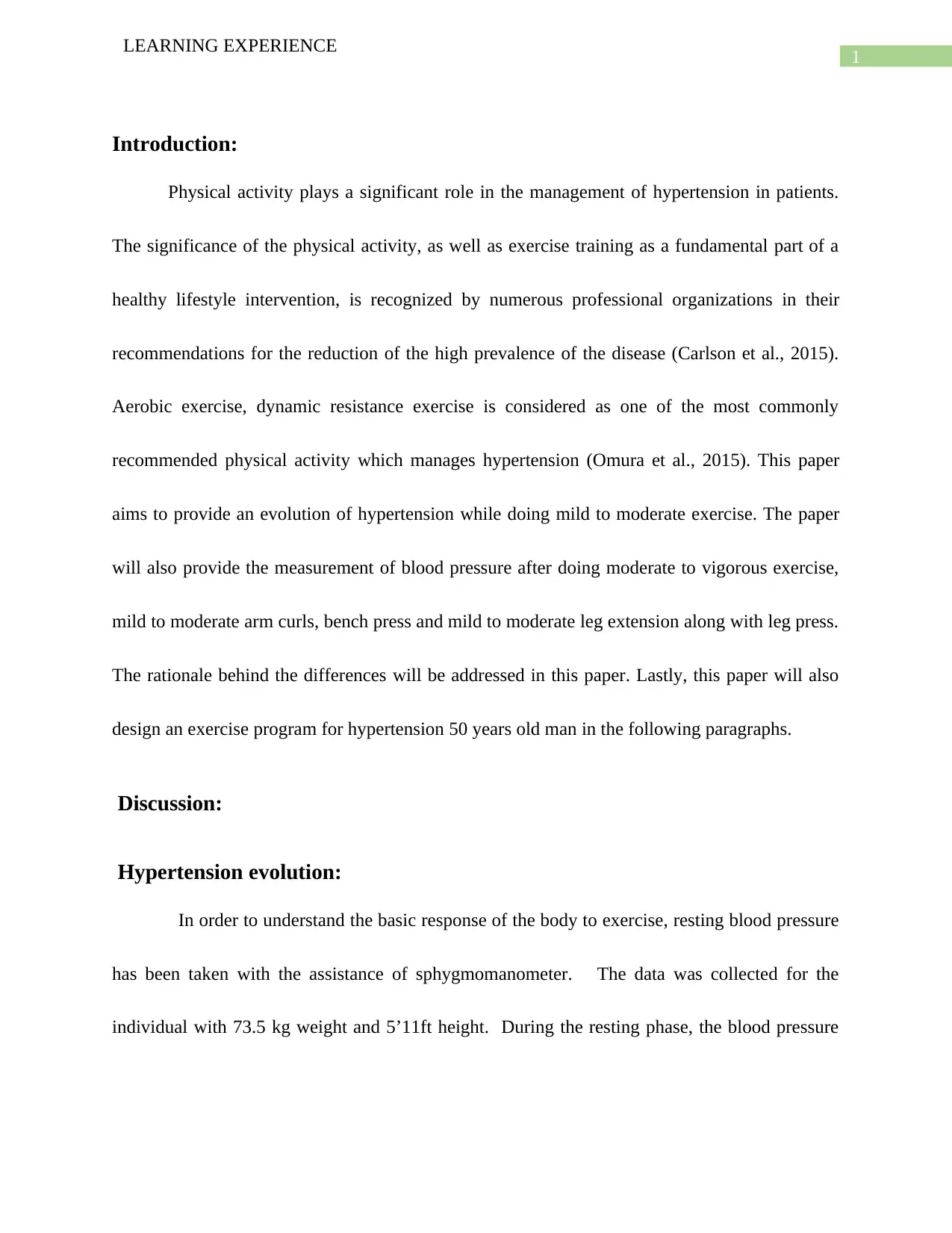
1
LEARNING EXPERIENCE
Introduction:
Physical activity plays a significant role in the management of hypertension in patients.
The significance of the physical activity, as well as exercise training as a fundamental part of a
healthy lifestyle intervention, is recognized by numerous professional organizations in their
recommendations for the reduction of the high prevalence of the disease (Carlson et al., 2015).
Aerobic exercise, dynamic resistance exercise is considered as one of the most commonly
recommended physical activity which manages hypertension (Omura et al., 2015). This paper
aims to provide an evolution of hypertension while doing mild to moderate exercise. The paper
will also provide the measurement of blood pressure after doing moderate to vigorous exercise,
mild to moderate arm curls, bench press and mild to moderate leg extension along with leg press.
The rationale behind the differences will be addressed in this paper. Lastly, this paper will also
design an exercise program for hypertension 50 years old man in the following paragraphs.
Discussion:
Hypertension evolution:
In order to understand the basic response of the body to exercise, resting blood pressure
has been taken with the assistance of sphygmomanometer. The data was collected for the
individual with 73.5 kg weight and 5’11ft height. During the resting phase, the blood pressure
LEARNING EXPERIENCE
Introduction:
Physical activity plays a significant role in the management of hypertension in patients.
The significance of the physical activity, as well as exercise training as a fundamental part of a
healthy lifestyle intervention, is recognized by numerous professional organizations in their
recommendations for the reduction of the high prevalence of the disease (Carlson et al., 2015).
Aerobic exercise, dynamic resistance exercise is considered as one of the most commonly
recommended physical activity which manages hypertension (Omura et al., 2015). This paper
aims to provide an evolution of hypertension while doing mild to moderate exercise. The paper
will also provide the measurement of blood pressure after doing moderate to vigorous exercise,
mild to moderate arm curls, bench press and mild to moderate leg extension along with leg press.
The rationale behind the differences will be addressed in this paper. Lastly, this paper will also
design an exercise program for hypertension 50 years old man in the following paragraphs.
Discussion:
Hypertension evolution:
In order to understand the basic response of the body to exercise, resting blood pressure
has been taken with the assistance of sphygmomanometer. The data was collected for the
individual with 73.5 kg weight and 5’11ft height. During the resting phase, the blood pressure
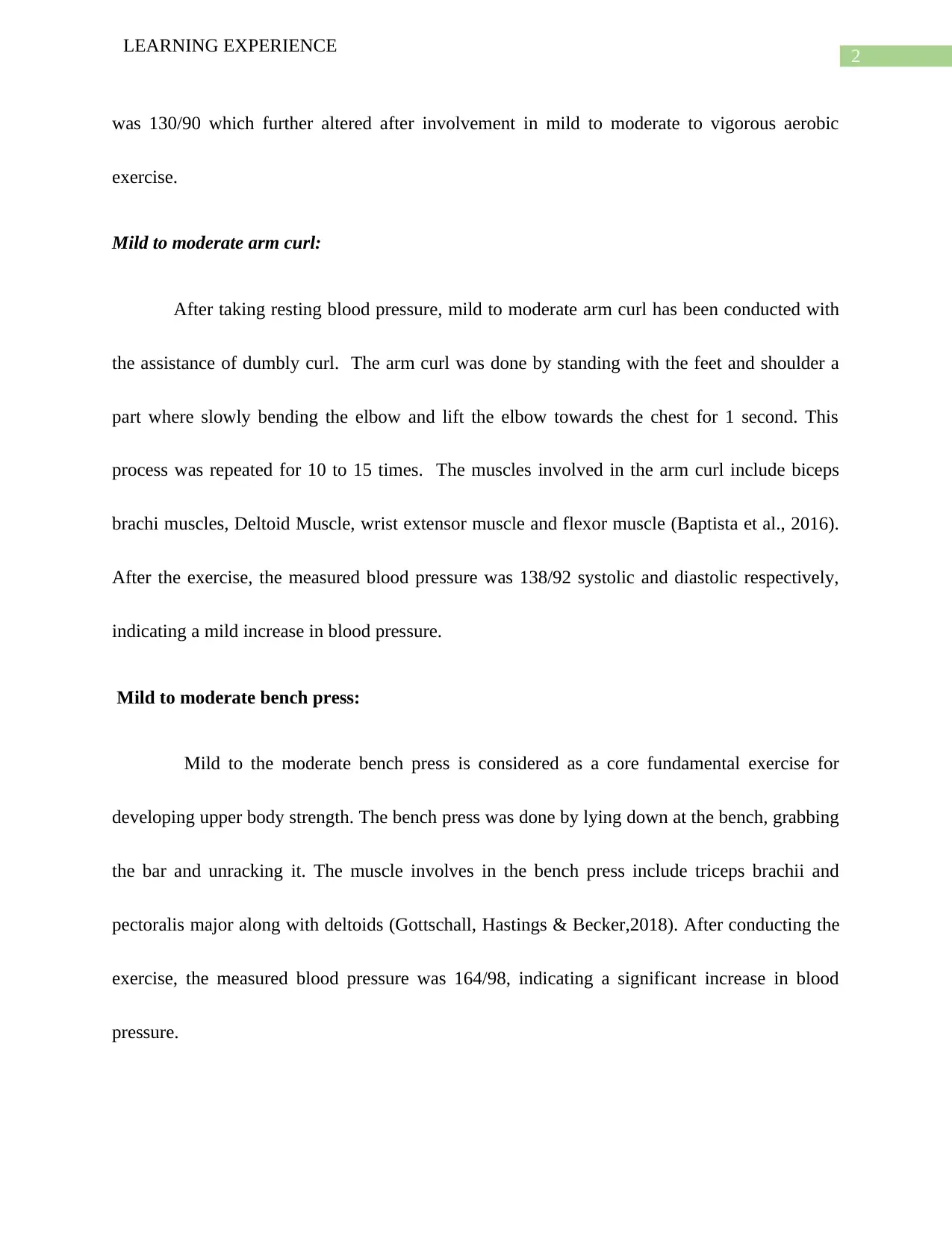
2
LEARNING EXPERIENCE
was 130/90 which further altered after involvement in mild to moderate to vigorous aerobic
exercise.
Mild to moderate arm curl:
After taking resting blood pressure, mild to moderate arm curl has been conducted with
the assistance of dumbly curl. The arm curl was done by standing with the feet and shoulder a
part where slowly bending the elbow and lift the elbow towards the chest for 1 second. This
process was repeated for 10 to 15 times. The muscles involved in the arm curl include biceps
brachi muscles, Deltoid Muscle, wrist extensor muscle and flexor muscle (Baptista et al., 2016).
After the exercise, the measured blood pressure was 138/92 systolic and diastolic respectively,
indicating a mild increase in blood pressure.
Mild to moderate bench press:
Mild to the moderate bench press is considered as a core fundamental exercise for
developing upper body strength. The bench press was done by lying down at the bench, grabbing
the bar and unracking it. The muscle involves in the bench press include triceps brachii and
pectoralis major along with deltoids (Gottschall, Hastings & Becker,2018). After conducting the
exercise, the measured blood pressure was 164/98, indicating a significant increase in blood
pressure.
LEARNING EXPERIENCE
was 130/90 which further altered after involvement in mild to moderate to vigorous aerobic
exercise.
Mild to moderate arm curl:
After taking resting blood pressure, mild to moderate arm curl has been conducted with
the assistance of dumbly curl. The arm curl was done by standing with the feet and shoulder a
part where slowly bending the elbow and lift the elbow towards the chest for 1 second. This
process was repeated for 10 to 15 times. The muscles involved in the arm curl include biceps
brachi muscles, Deltoid Muscle, wrist extensor muscle and flexor muscle (Baptista et al., 2016).
After the exercise, the measured blood pressure was 138/92 systolic and diastolic respectively,
indicating a mild increase in blood pressure.
Mild to moderate bench press:
Mild to the moderate bench press is considered as a core fundamental exercise for
developing upper body strength. The bench press was done by lying down at the bench, grabbing
the bar and unracking it. The muscle involves in the bench press include triceps brachii and
pectoralis major along with deltoids (Gottschall, Hastings & Becker,2018). After conducting the
exercise, the measured blood pressure was 164/98, indicating a significant increase in blood
pressure.
⊘ This is a preview!⊘
Do you want full access?
Subscribe today to unlock all pages.

Trusted by 1+ million students worldwide
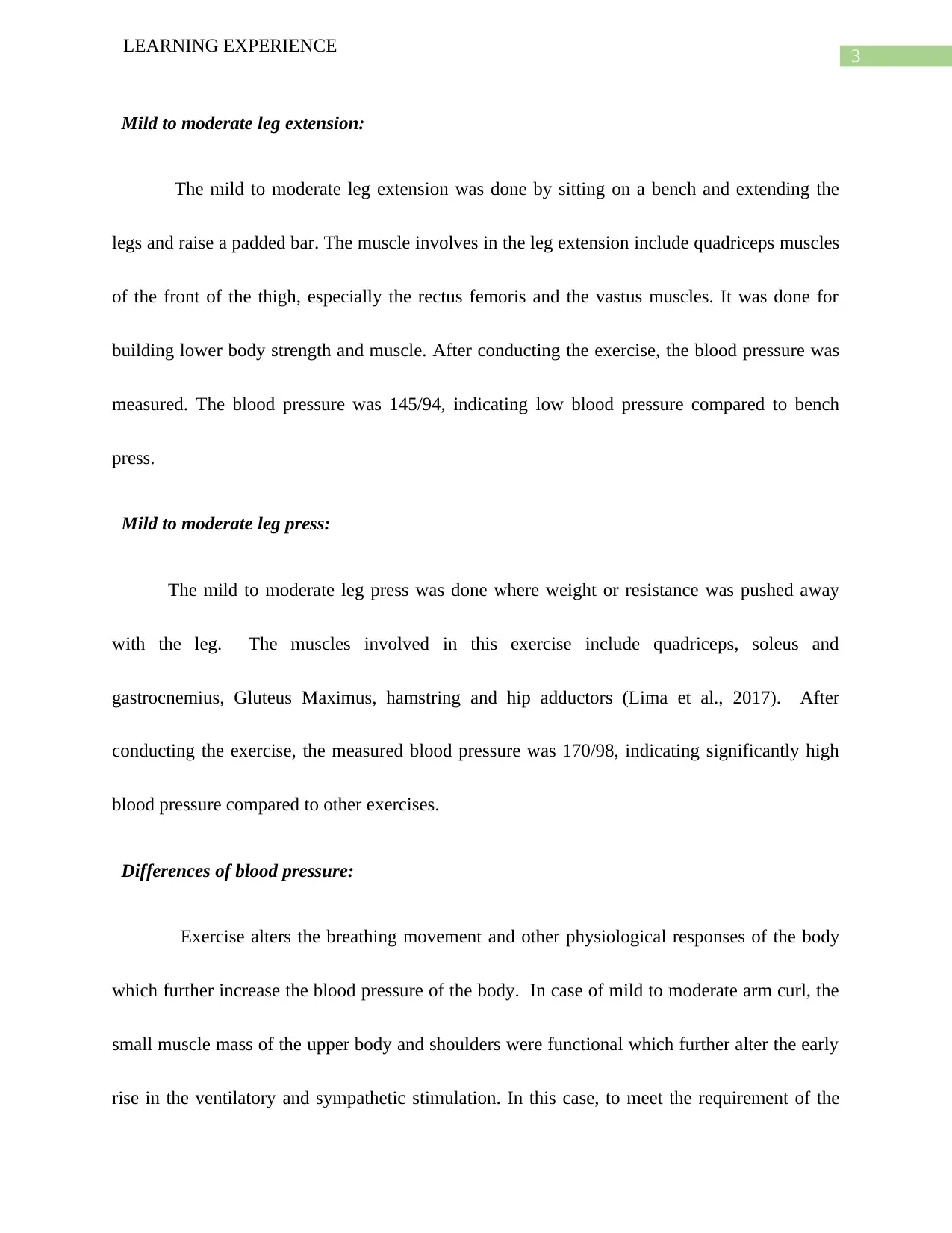
3
LEARNING EXPERIENCE
Mild to moderate leg extension:
The mild to moderate leg extension was done by sitting on a bench and extending the
legs and raise a padded bar. The muscle involves in the leg extension include quadriceps muscles
of the front of the thigh, especially the rectus femoris and the vastus muscles. It was done for
building lower body strength and muscle. After conducting the exercise, the blood pressure was
measured. The blood pressure was 145/94, indicating low blood pressure compared to bench
press.
Mild to moderate leg press:
The mild to moderate leg press was done where weight or resistance was pushed away
with the leg. The muscles involved in this exercise include quadriceps, soleus and
gastrocnemius, Gluteus Maximus, hamstring and hip adductors (Lima et al., 2017). After
conducting the exercise, the measured blood pressure was 170/98, indicating significantly high
blood pressure compared to other exercises.
Differences of blood pressure:
Exercise alters the breathing movement and other physiological responses of the body
which further increase the blood pressure of the body. In case of mild to moderate arm curl, the
small muscle mass of the upper body and shoulders were functional which further alter the early
rise in the ventilatory and sympathetic stimulation. In this case, to meet the requirement of the
LEARNING EXPERIENCE
Mild to moderate leg extension:
The mild to moderate leg extension was done by sitting on a bench and extending the
legs and raise a padded bar. The muscle involves in the leg extension include quadriceps muscles
of the front of the thigh, especially the rectus femoris and the vastus muscles. It was done for
building lower body strength and muscle. After conducting the exercise, the blood pressure was
measured. The blood pressure was 145/94, indicating low blood pressure compared to bench
press.
Mild to moderate leg press:
The mild to moderate leg press was done where weight or resistance was pushed away
with the leg. The muscles involved in this exercise include quadriceps, soleus and
gastrocnemius, Gluteus Maximus, hamstring and hip adductors (Lima et al., 2017). After
conducting the exercise, the measured blood pressure was 170/98, indicating significantly high
blood pressure compared to other exercises.
Differences of blood pressure:
Exercise alters the breathing movement and other physiological responses of the body
which further increase the blood pressure of the body. In case of mild to moderate arm curl, the
small muscle mass of the upper body and shoulders were functional which further alter the early
rise in the ventilatory and sympathetic stimulation. In this case, to meet the requirement of the
Paraphrase This Document
Need a fresh take? Get an instant paraphrase of this document with our AI Paraphraser
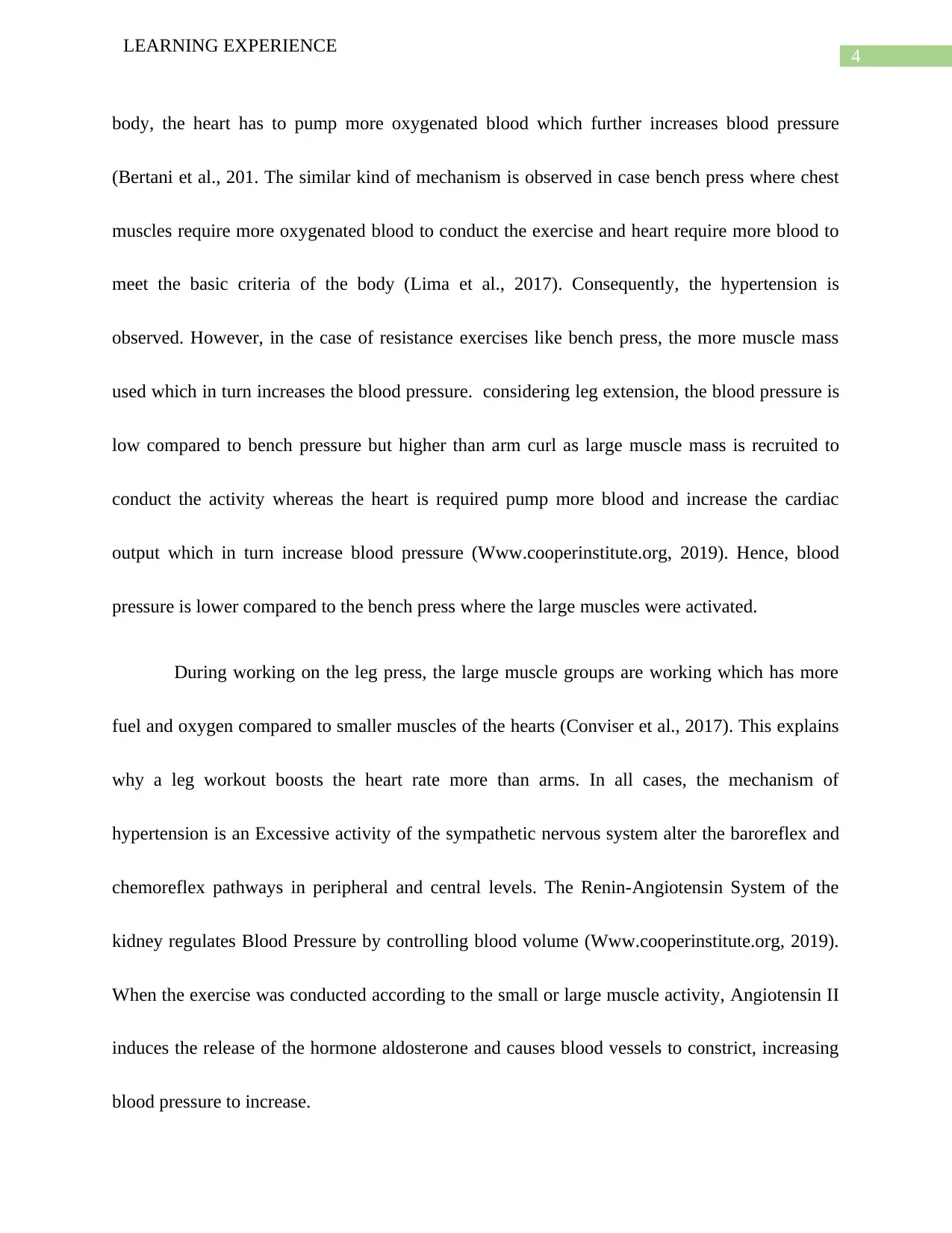
4
LEARNING EXPERIENCE
body, the heart has to pump more oxygenated blood which further increases blood pressure
(Bertani et al., 201. The similar kind of mechanism is observed in case bench press where chest
muscles require more oxygenated blood to conduct the exercise and heart require more blood to
meet the basic criteria of the body (Lima et al., 2017). Consequently, the hypertension is
observed. However, in the case of resistance exercises like bench press, the more muscle mass
used which in turn increases the blood pressure. considering leg extension, the blood pressure is
low compared to bench pressure but higher than arm curl as large muscle mass is recruited to
conduct the activity whereas the heart is required pump more blood and increase the cardiac
output which in turn increase blood pressure (Www.cooperinstitute.org, 2019). Hence, blood
pressure is lower compared to the bench press where the large muscles were activated.
During working on the leg press, the large muscle groups are working which has more
fuel and oxygen compared to smaller muscles of the hearts (Conviser et al., 2017). This explains
why a leg workout boosts the heart rate more than arms. In all cases, the mechanism of
hypertension is an Excessive activity of the sympathetic nervous system alter the baroreflex and
chemoreflex pathways in peripheral and central levels. The Renin-Angiotensin System of the
kidney regulates Blood Pressure by controlling blood volume (Www.cooperinstitute.org, 2019).
When the exercise was conducted according to the small or large muscle activity, Angiotensin II
induces the release of the hormone aldosterone and causes blood vessels to constrict, increasing
blood pressure to increase.
LEARNING EXPERIENCE
body, the heart has to pump more oxygenated blood which further increases blood pressure
(Bertani et al., 201. The similar kind of mechanism is observed in case bench press where chest
muscles require more oxygenated blood to conduct the exercise and heart require more blood to
meet the basic criteria of the body (Lima et al., 2017). Consequently, the hypertension is
observed. However, in the case of resistance exercises like bench press, the more muscle mass
used which in turn increases the blood pressure. considering leg extension, the blood pressure is
low compared to bench pressure but higher than arm curl as large muscle mass is recruited to
conduct the activity whereas the heart is required pump more blood and increase the cardiac
output which in turn increase blood pressure (Www.cooperinstitute.org, 2019). Hence, blood
pressure is lower compared to the bench press where the large muscles were activated.
During working on the leg press, the large muscle groups are working which has more
fuel and oxygen compared to smaller muscles of the hearts (Conviser et al., 2017). This explains
why a leg workout boosts the heart rate more than arms. In all cases, the mechanism of
hypertension is an Excessive activity of the sympathetic nervous system alter the baroreflex and
chemoreflex pathways in peripheral and central levels. The Renin-Angiotensin System of the
kidney regulates Blood Pressure by controlling blood volume (Www.cooperinstitute.org, 2019).
When the exercise was conducted according to the small or large muscle activity, Angiotensin II
induces the release of the hormone aldosterone and causes blood vessels to constrict, increasing
blood pressure to increase.
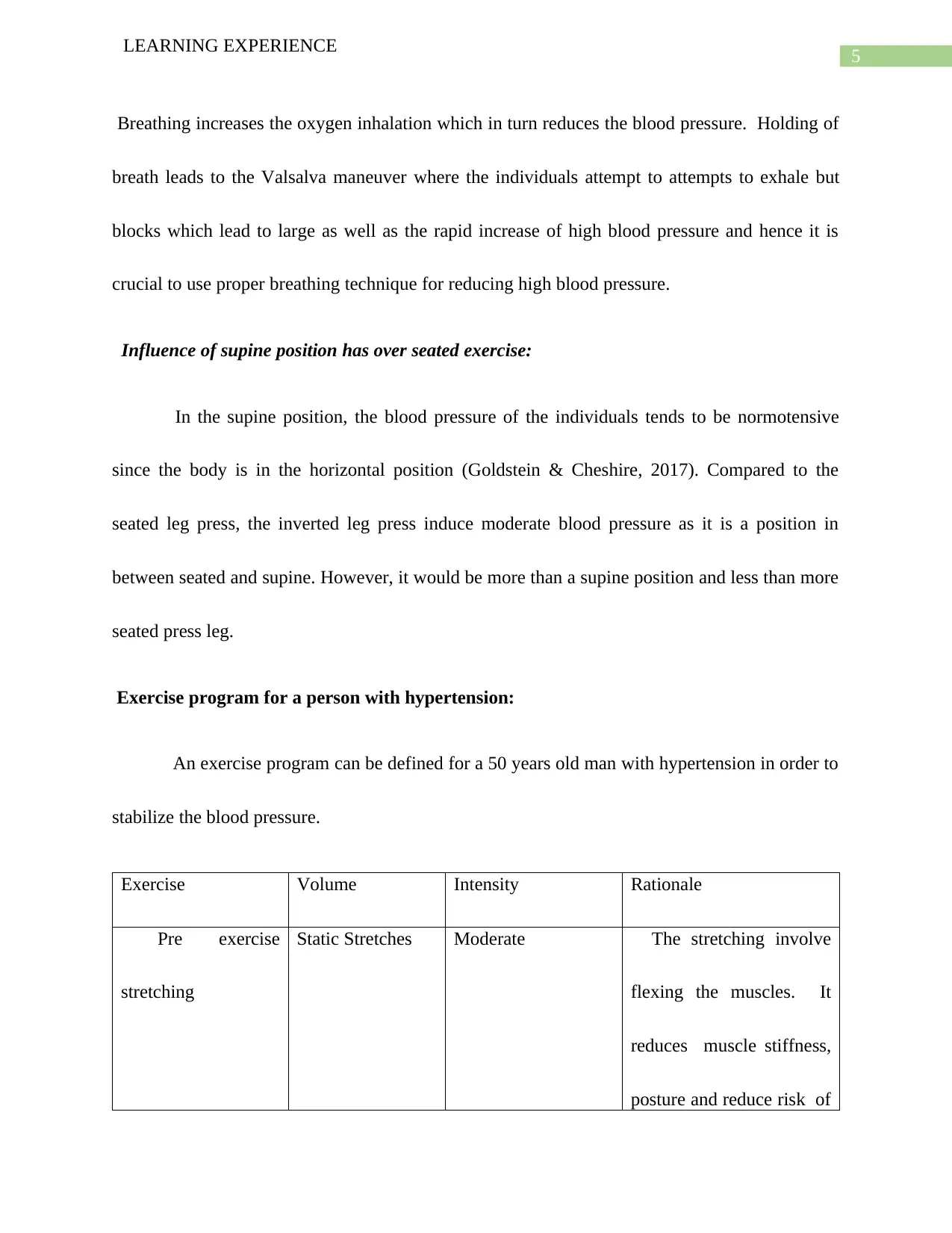
5
LEARNING EXPERIENCE
Breathing increases the oxygen inhalation which in turn reduces the blood pressure. Holding of
breath leads to the Valsalva maneuver where the individuals attempt to attempts to exhale but
blocks which lead to large as well as the rapid increase of high blood pressure and hence it is
crucial to use proper breathing technique for reducing high blood pressure.
Influence of supine position has over seated exercise:
In the supine position, the blood pressure of the individuals tends to be normotensive
since the body is in the horizontal position (Goldstein & Cheshire, 2017). Compared to the
seated leg press, the inverted leg press induce moderate blood pressure as it is a position in
between seated and supine. However, it would be more than a supine position and less than more
seated press leg.
Exercise program for a person with hypertension:
An exercise program can be defined for a 50 years old man with hypertension in order to
stabilize the blood pressure.
Exercise Volume Intensity Rationale
Pre exercise
stretching
Static Stretches Moderate The stretching involve
flexing the muscles. It
reduces muscle stiffness,
posture and reduce risk of
LEARNING EXPERIENCE
Breathing increases the oxygen inhalation which in turn reduces the blood pressure. Holding of
breath leads to the Valsalva maneuver where the individuals attempt to attempts to exhale but
blocks which lead to large as well as the rapid increase of high blood pressure and hence it is
crucial to use proper breathing technique for reducing high blood pressure.
Influence of supine position has over seated exercise:
In the supine position, the blood pressure of the individuals tends to be normotensive
since the body is in the horizontal position (Goldstein & Cheshire, 2017). Compared to the
seated leg press, the inverted leg press induce moderate blood pressure as it is a position in
between seated and supine. However, it would be more than a supine position and less than more
seated press leg.
Exercise program for a person with hypertension:
An exercise program can be defined for a 50 years old man with hypertension in order to
stabilize the blood pressure.
Exercise Volume Intensity Rationale
Pre exercise
stretching
Static Stretches Moderate The stretching involve
flexing the muscles. It
reduces muscle stiffness,
posture and reduce risk of
⊘ This is a preview!⊘
Do you want full access?
Subscribe today to unlock all pages.

Trusted by 1+ million students worldwide
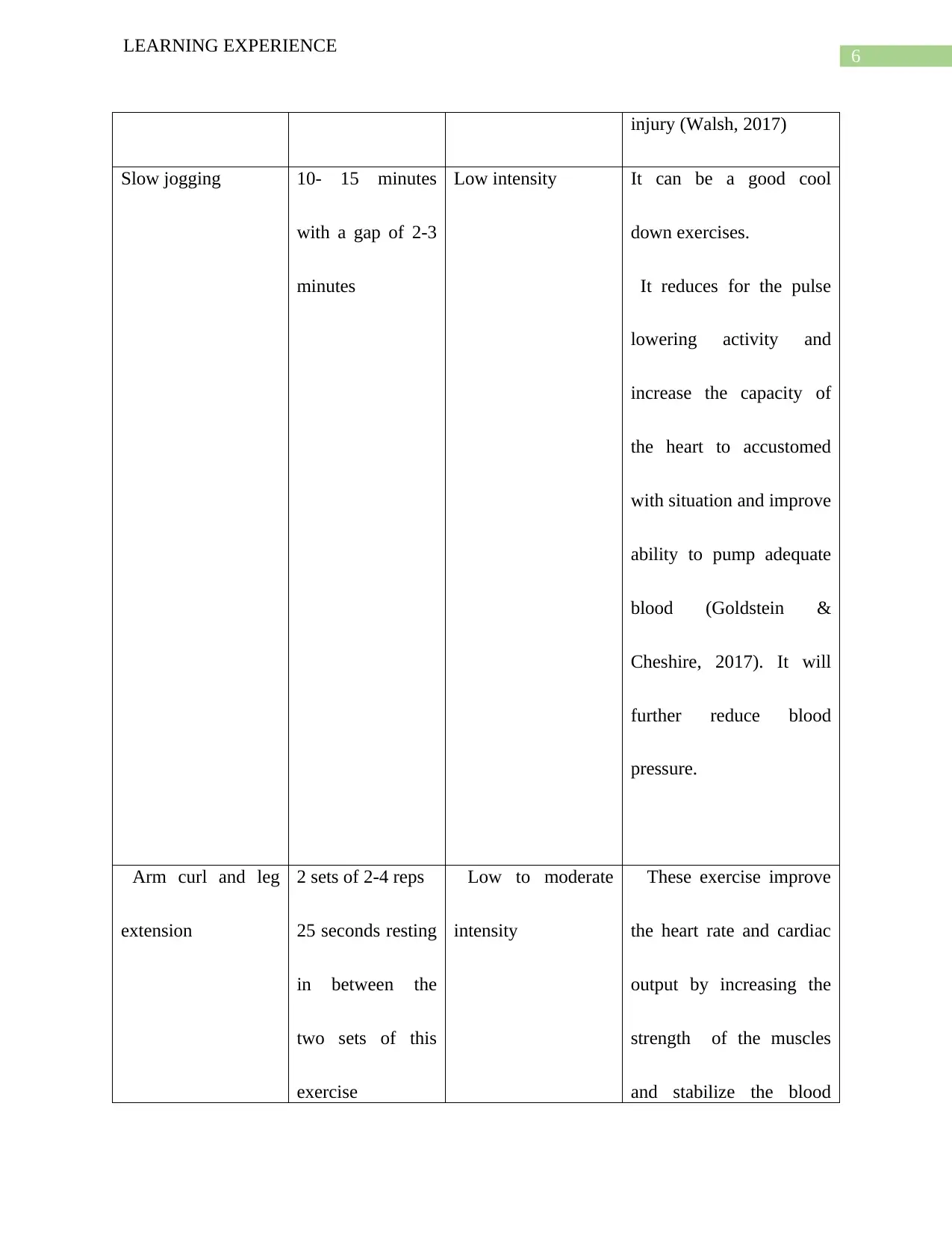
6
LEARNING EXPERIENCE
injury (Walsh, 2017)
Slow jogging 10- 15 minutes
with a gap of 2-3
minutes
Low intensity It can be a good cool
down exercises.
It reduces for the pulse
lowering activity and
increase the capacity of
the heart to accustomed
with situation and improve
ability to pump adequate
blood (Goldstein &
Cheshire, 2017). It will
further reduce blood
pressure.
Arm curl and leg
extension
2 sets of 2-4 reps
25 seconds resting
in between the
two sets of this
exercise
Low to moderate
intensity
These exercise improve
the heart rate and cardiac
output by increasing the
strength of the muscles
and stabilize the blood
LEARNING EXPERIENCE
injury (Walsh, 2017)
Slow jogging 10- 15 minutes
with a gap of 2-3
minutes
Low intensity It can be a good cool
down exercises.
It reduces for the pulse
lowering activity and
increase the capacity of
the heart to accustomed
with situation and improve
ability to pump adequate
blood (Goldstein &
Cheshire, 2017). It will
further reduce blood
pressure.
Arm curl and leg
extension
2 sets of 2-4 reps
25 seconds resting
in between the
two sets of this
exercise
Low to moderate
intensity
These exercise improve
the heart rate and cardiac
output by increasing the
strength of the muscles
and stabilize the blood
Paraphrase This Document
Need a fresh take? Get an instant paraphrase of this document with our AI Paraphraser
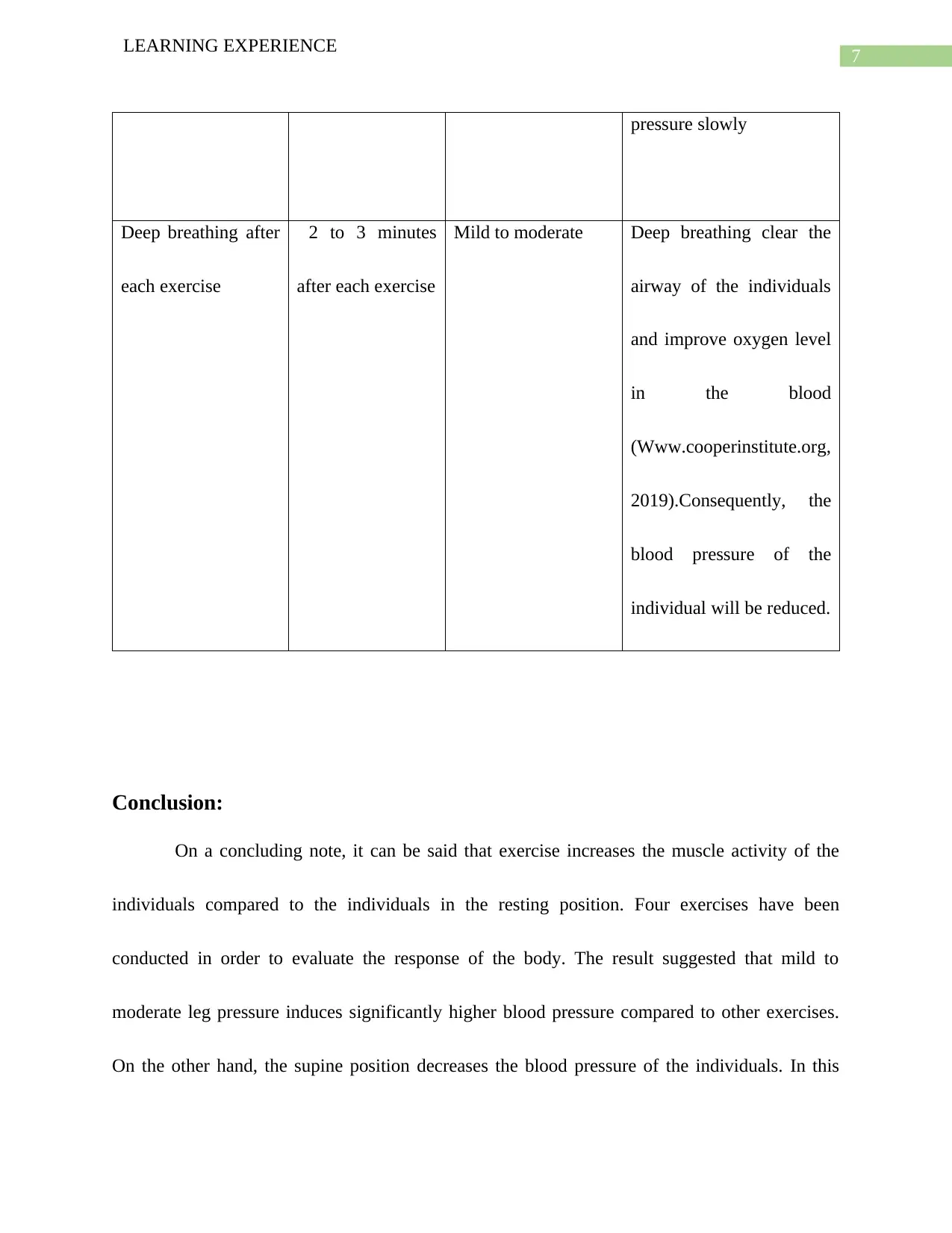
7
LEARNING EXPERIENCE
pressure slowly
Deep breathing after
each exercise
2 to 3 minutes
after each exercise
Mild to moderate Deep breathing clear the
airway of the individuals
and improve oxygen level
in the blood
(Www.cooperinstitute.org,
2019).Consequently, the
blood pressure of the
individual will be reduced.
Conclusion:
On a concluding note, it can be said that exercise increases the muscle activity of the
individuals compared to the individuals in the resting position. Four exercises have been
conducted in order to evaluate the response of the body. The result suggested that mild to
moderate leg pressure induces significantly higher blood pressure compared to other exercises.
On the other hand, the supine position decreases the blood pressure of the individuals. In this
LEARNING EXPERIENCE
pressure slowly
Deep breathing after
each exercise
2 to 3 minutes
after each exercise
Mild to moderate Deep breathing clear the
airway of the individuals
and improve oxygen level
in the blood
(Www.cooperinstitute.org,
2019).Consequently, the
blood pressure of the
individual will be reduced.
Conclusion:
On a concluding note, it can be said that exercise increases the muscle activity of the
individuals compared to the individuals in the resting position. Four exercises have been
conducted in order to evaluate the response of the body. The result suggested that mild to
moderate leg pressure induces significantly higher blood pressure compared to other exercises.
On the other hand, the supine position decreases the blood pressure of the individuals. In this
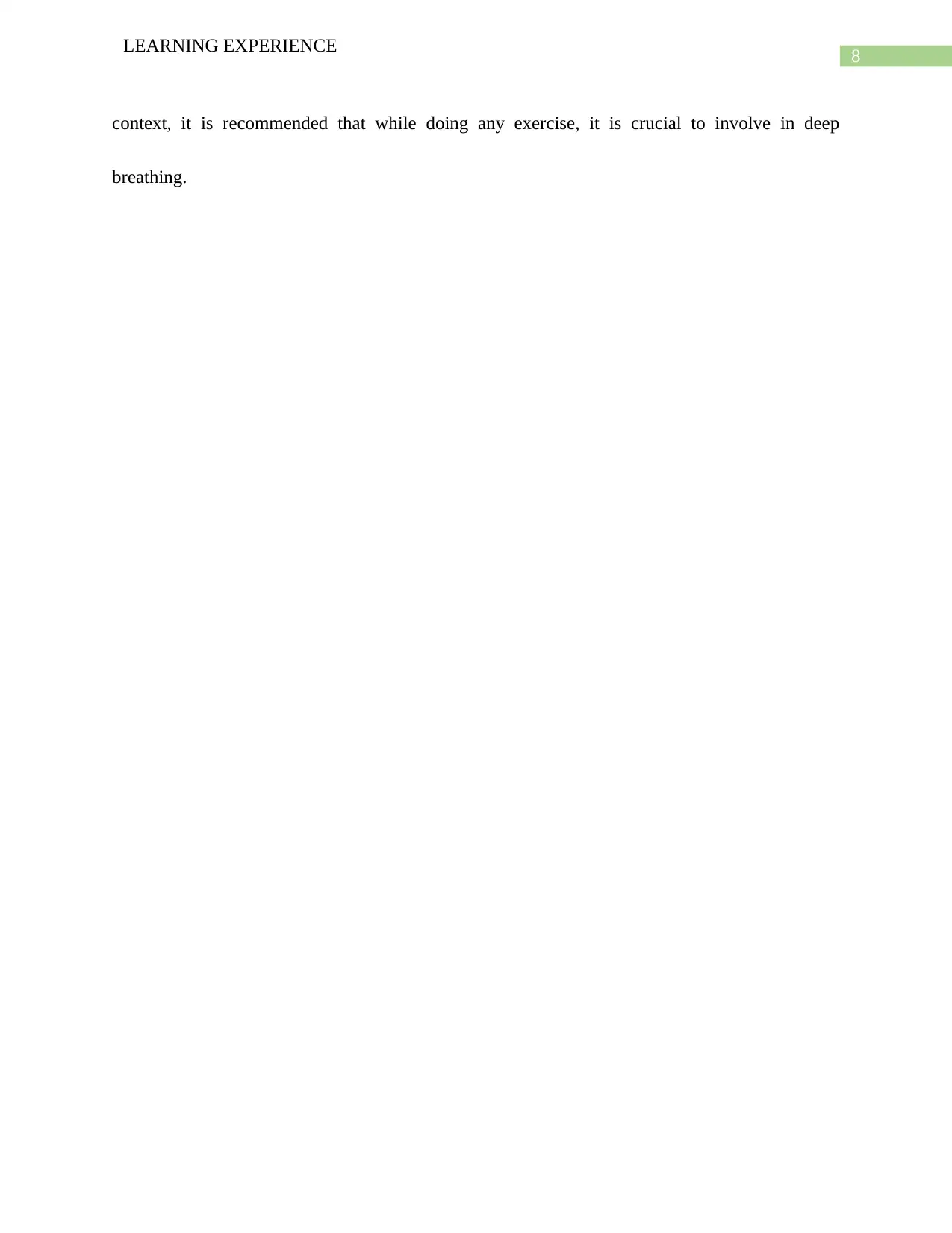
8
LEARNING EXPERIENCE
context, it is recommended that while doing any exercise, it is crucial to involve in deep
breathing.
LEARNING EXPERIENCE
context, it is recommended that while doing any exercise, it is crucial to involve in deep
breathing.
⊘ This is a preview!⊘
Do you want full access?
Subscribe today to unlock all pages.

Trusted by 1+ million students worldwide

9
LEARNING EXPERIENCE
References:
Baptista, L. C., Machado-Rodrigues, A. M., Veríssimo, M. T., & Martins, R. A. (2018). Exercise
training improves functional status in hypertensive older adults under angiotensin
converting enzymes inhibitors medication. Experimental gerontology, 109, 82-89.
Bertani, R. F., Campos, G. O., Perseguin, D. M., Bonardi, J. M., Ferriolli, E., Moriguti, J. C., &
Lima, N. K. (2018). Resistance Exercise Training Is More Effective than Interval Aerobic
Training in Reducing Blood Pressure During Sleep in Hypertensive Elderly Patients. The
Journal of Strength & Conditioning Research, 32(7), 2085-2090.
Carlson, S. A., Fulton, J. E., Pratt, M., Yang, Z., & Adams, E. K. (2015). Inadequate physical
activity and health care expenditures in the United States. Progress in cardiovascular
diseases, 57(4), 315-323.
Conviser, J. M., Ng, A. V., Rockey, S. S., & Thomas, D. P. (2017). Cardio-protection afforded
by β-blockade is maintained during resistance exercise. Journal of science and medicine
in sport, 20(2), 196-201.
Goldstein, D. S., & Cheshire, W. P. (2017). Beat-to-beat blood pressure and heart rate responses
to the Valsalva maneuver. Clinical Autonomic Research, 27(6), 361-367.
Gottschall, J. S., Hastings, B., & Becker, Z. (2018). Muscle Activity Patterns do not Differ
Between Push-Up and Bench Press Exercises. Journal of applied biomechanics, 34(6),
442-447.
LEARNING EXPERIENCE
References:
Baptista, L. C., Machado-Rodrigues, A. M., Veríssimo, M. T., & Martins, R. A. (2018). Exercise
training improves functional status in hypertensive older adults under angiotensin
converting enzymes inhibitors medication. Experimental gerontology, 109, 82-89.
Bertani, R. F., Campos, G. O., Perseguin, D. M., Bonardi, J. M., Ferriolli, E., Moriguti, J. C., &
Lima, N. K. (2018). Resistance Exercise Training Is More Effective than Interval Aerobic
Training in Reducing Blood Pressure During Sleep in Hypertensive Elderly Patients. The
Journal of Strength & Conditioning Research, 32(7), 2085-2090.
Carlson, S. A., Fulton, J. E., Pratt, M., Yang, Z., & Adams, E. K. (2015). Inadequate physical
activity and health care expenditures in the United States. Progress in cardiovascular
diseases, 57(4), 315-323.
Conviser, J. M., Ng, A. V., Rockey, S. S., & Thomas, D. P. (2017). Cardio-protection afforded
by β-blockade is maintained during resistance exercise. Journal of science and medicine
in sport, 20(2), 196-201.
Goldstein, D. S., & Cheshire, W. P. (2017). Beat-to-beat blood pressure and heart rate responses
to the Valsalva maneuver. Clinical Autonomic Research, 27(6), 361-367.
Gottschall, J. S., Hastings, B., & Becker, Z. (2018). Muscle Activity Patterns do not Differ
Between Push-Up and Bench Press Exercises. Journal of applied biomechanics, 34(6),
442-447.
Paraphrase This Document
Need a fresh take? Get an instant paraphrase of this document with our AI Paraphraser
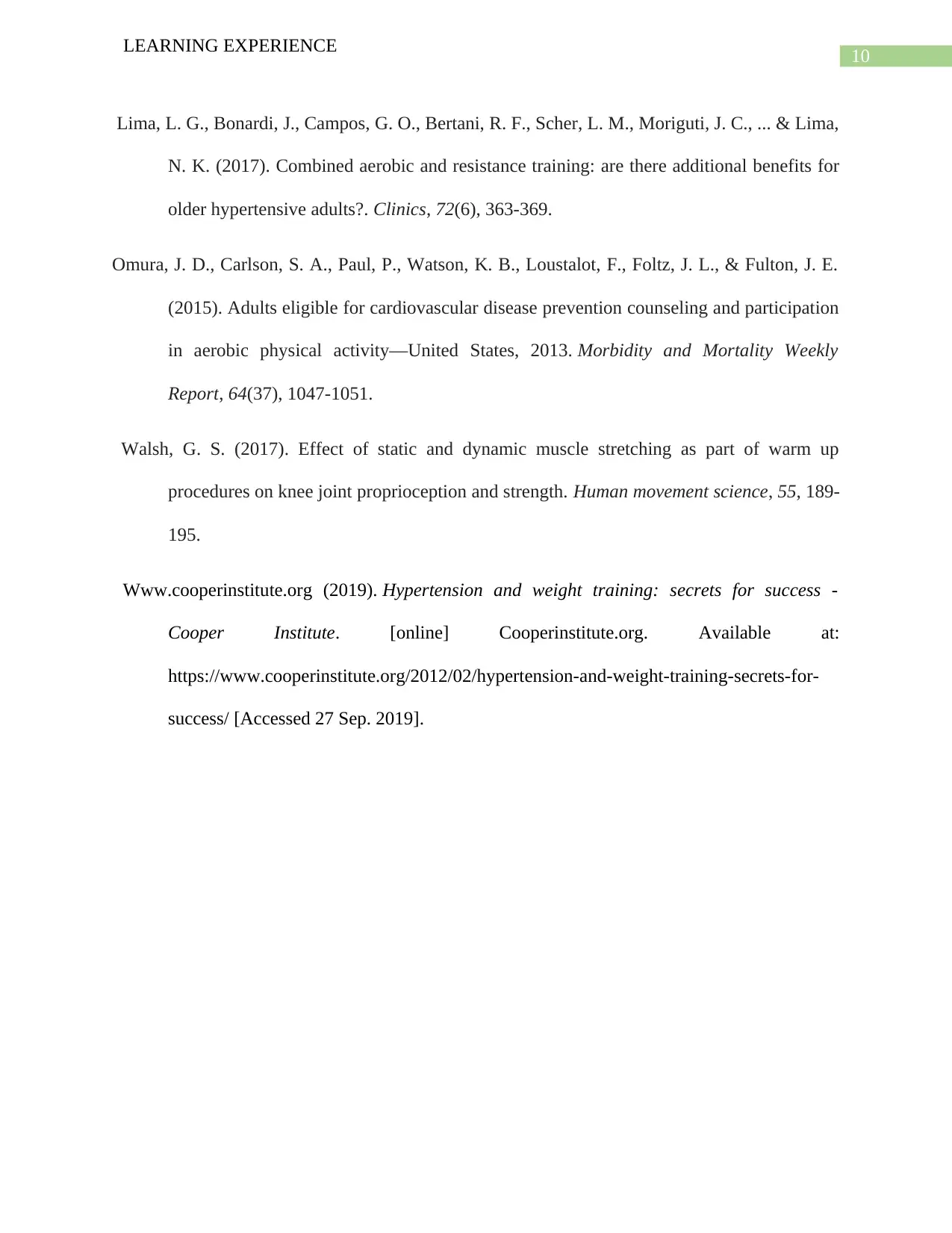
10
LEARNING EXPERIENCE
Lima, L. G., Bonardi, J., Campos, G. O., Bertani, R. F., Scher, L. M., Moriguti, J. C., ... & Lima,
N. K. (2017). Combined aerobic and resistance training: are there additional benefits for
older hypertensive adults?. Clinics, 72(6), 363-369.
Omura, J. D., Carlson, S. A., Paul, P., Watson, K. B., Loustalot, F., Foltz, J. L., & Fulton, J. E.
(2015). Adults eligible for cardiovascular disease prevention counseling and participation
in aerobic physical activity—United States, 2013. Morbidity and Mortality Weekly
Report, 64(37), 1047-1051.
Walsh, G. S. (2017). Effect of static and dynamic muscle stretching as part of warm up
procedures on knee joint proprioception and strength. Human movement science, 55, 189-
195.
Www.cooperinstitute.org (2019). Hypertension and weight training: secrets for success -
Cooper Institute. [online] Cooperinstitute.org. Available at:
https://www.cooperinstitute.org/2012/02/hypertension-and-weight-training-secrets-for-
success/ [Accessed 27 Sep. 2019].
LEARNING EXPERIENCE
Lima, L. G., Bonardi, J., Campos, G. O., Bertani, R. F., Scher, L. M., Moriguti, J. C., ... & Lima,
N. K. (2017). Combined aerobic and resistance training: are there additional benefits for
older hypertensive adults?. Clinics, 72(6), 363-369.
Omura, J. D., Carlson, S. A., Paul, P., Watson, K. B., Loustalot, F., Foltz, J. L., & Fulton, J. E.
(2015). Adults eligible for cardiovascular disease prevention counseling and participation
in aerobic physical activity—United States, 2013. Morbidity and Mortality Weekly
Report, 64(37), 1047-1051.
Walsh, G. S. (2017). Effect of static and dynamic muscle stretching as part of warm up
procedures on knee joint proprioception and strength. Human movement science, 55, 189-
195.
Www.cooperinstitute.org (2019). Hypertension and weight training: secrets for success -
Cooper Institute. [online] Cooperinstitute.org. Available at:
https://www.cooperinstitute.org/2012/02/hypertension-and-weight-training-secrets-for-
success/ [Accessed 27 Sep. 2019].
1 out of 11
Related Documents
Your All-in-One AI-Powered Toolkit for Academic Success.
+13062052269
info@desklib.com
Available 24*7 on WhatsApp / Email
![[object Object]](/_next/static/media/star-bottom.7253800d.svg)
Unlock your academic potential
Copyright © 2020–2026 A2Z Services. All Rights Reserved. Developed and managed by ZUCOL.




